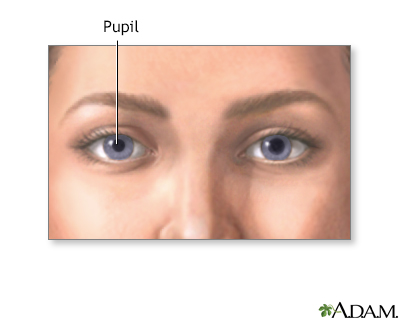
Remove the light and wait a few seconds for the eyes to equalize in the dim light again, and test the second eye as you did the first.As the light is kept on the first eye for several seconds, the pupil should maintain its smaller size (with small variations as it “bounces” slightly), and should not get significantly larger as you watch.There should be a rapid decrease in pupil size, and then, as the tester watches without removing the light just yet, it will get slightly larger and “bounce” its size up and down a little bit. This first Direct Response is the pupil reacting to the dimness of the room and then to the bright light. As the pupil reacts to the bright light, its normal response will be to get smaller.(Exactly how large depends on a lot of other factors, like how dim the room is, and how bright the light is, and any meds the person may be using, so don’t worry about exactly HOW large, just that it is larger than “normal” for that eye.) Watch the pupil as you shine the light into the eye it should start out somewhat larger to begin with than it was in normal room light.It is not necessary that the patient cover the other eye, just that light isn’t allowed to cross the bridge of the nose into the other eye. Using a narrow-beam bright flashlight such as a penlight (NOT a laser pointer!), shine the light into either eye, but not into the other one just yet.The expected response here is that both pupils will dilate (expand) to allow more light into the eye under low light conditions. Look at both pupils in normal room light, to get an idea of two things: How large or small they are under usual conditions, and if they are roughly equal in size when compared.ĭarken the room and wait one or two minutes for the pupils to adapt to the darkness. The Direct Response of the pupil to its own environment should always be the stronger, over the Indirect Response. The Indirect Response is when fellow eye sends messages to the tested eye, telling it to dilate again, because the fellow eye is still in the dark. When a light is shined into the eye, its strongest reaction is from the Direct Response, and is just what you expect: the pupil should get smaller when a light is shined directly into it. There are two main pupillary responses to light, the Direct and Indirect. Duplication for commercial use must be authorized in writing by ADAM Health Solutions.In the case of brain injury (concussion, for example) the pupils sometimes give us information about where and how severely the brain might be effected. Links to other sites are provided for information only - they do not constitute endorsements of those other sites. A licensed physician should be consulted for diagnosis and treatment of any and all medical conditions. The information provided herein should not be used during any medical emergency or for the diagnosis or treatment of any medical condition. This site complies with the HONcode standard for trustworthy health information: verify here. Learn more about A.D.A.M.'s editorial policy editorial process and privacy policy. is among the first to achieve this important distinction for online health information and services. follows rigorous standards of quality and accountability. is accredited by URAC, for Health Content Provider (URAC's accreditation program is an independent audit to verify that A.D.A.M.

Injury to the carotid or vertebral arteryĪ.D.A.M., Inc.Tumor, mass, or lymph node in the upper chest or lymph node causing pressure on a nerve may cause decreased sweating, a small pupil, or drooping eyelid all on the affected side (Horner syndrome).


The use of eye drops is a common cause of a harmless change in pupil size.


 0 kommentar(er)
0 kommentar(er)
